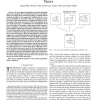Free Online Productivity Tools
i2Speak
i2Symbol
i2OCR
iTex2Img
iWeb2Print
iWeb2Shot
i2Type
iPdf2Split
iPdf2Merge
i2Bopomofo
i2Arabic
i2Style
i2Image
i2PDF
iLatex2Rtf
Sci2ools
TEC
2002
2002
Genetic object recognition using combinations of views
We investigate the application of genetic algorithms (GAs) for recognizing real two-dimensional (2-D) or three-dimensional (3-D) objects from 2-D intensity images, assuming that the viewpoint is arbitrary. Our approach is model-based (i.e., we assume a predefined set of models), while our recognition strategy lies on the recently proposed theory of algebraic functions of views. According to this theory, the variety of 2-D views depicting an object can be expressed as a combination of a small number of 2-D views of the object. This implies a simple and powerful strategy for object recognition: novel 2-D views of an object (2-D or 3-D) can be recognized by simply matching them to combinations of known 2-D views of the object. In other words, objects in a scene are recognized by "predicting" their appearance through the combination of known views of the objects. This is an important idea, which is also supported by psychophysical findings indicating that the human visual system ...
2-D Intensity Images | 2-D Views | Space | TEC 2002 |
| Added | 23 Dec 2010 |
| Updated | 23 Dec 2010 |
| Type | Journal |
| Year | 2002 |
| Where | TEC |
| Authors | George Bebis, Evangelos A. Yfantis, Sushil J. Louis, Yaakov L. Varol |
Comments (0)

